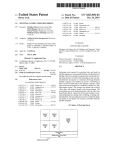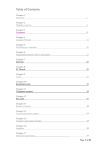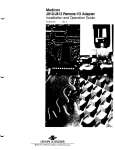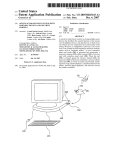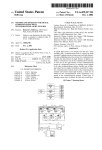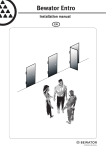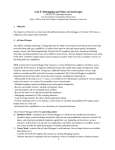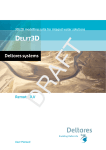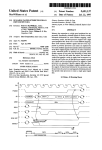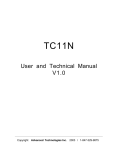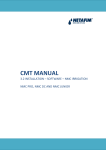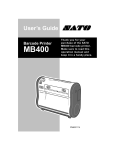Download Secure and efficient login and transaction authentication using
Transcript
US 20110265149Al
(19) United States
(12) Patent Application Publication (10) Pub. No.: US 2011/0265149 A1
Ganesan
(54)
(43) Pub. Date:
SECURE AND EFFICIENT LOGIN AND
TRANSACTION AUTHENTICATION USING
Publication Classi?cation
(51)
IPHONESTM AND OTHER SMART MOBILE
COMMUNICATION DEVICES
(75) Inventor:
FL (Us )
(57)
ABSTRACT
logm or transactlon authorizatlon, a ?rst applicatlon on the
device directs transmission of a request for authentication of
ASSlgnee;
HAWK AND SEAL, INC,
the user to a security server. A second application on the
device receives the request for authentication from the secu
rity server and directs presentation of the received request for
authentication to the user by the device. The second applica
tion receives a user input to the device indicating that the
Chica g0, IL US
(2I)
(200601)
us. Cl. .......................................................... .. 726/4
To authenticate
a. user of a mobile
communication
device for
.
.
.
.
.
_
(73)
Int Cl
H02”, /32
(52)
Ravi Ganesan, West Palm Beach,
Oct. 27, 2011
APPI- NOJ
13/081,067
requested authentication should proceed and in response
-
(22)
_
directs transmission of an indication that the requested autho
Flled'
Apr‘ 6’ 2011
Provisional application No. 61/327,723, ?led on Apr.
riZation should proceed, to the security server. In response to
this latter transmission, the second application receives a PIN
from the authentication server. The ?rst application directs
transmission of the PIN received by the second application to
the network site, Which validates the transmitted PIN, in order
26, 2010.
to authenticate the user or the transaction to the network site.
Related US, Application Data
(60)
USER DESKTOP
:
POP-U P
WINDOW
BROWSER
OUT OF BAND
AUTHENTICATION
/’\\
SECURITY
SERVER
WEBSITE
Patent Application Publication
Oct. 27, 2011 Sheet 1 0f 12
US 2011/0265149 A1
USER DESKTOP
POP-UP
WINDOW
_
BROWSER
SECURITY
SERVER
Figure 1
WEBSITE
Patent Application Publication
Oct. 27, 2011 Sheet 2 0f 12
US 2011/0265149 A1
USER DESKTOP
:
POP-UP
WINDOW
BRQWSER
OUTOF BAND
‘
AUTHENTICATION ‘
/?\
SECURITY
SERVER
Figure 2
WEBS'TE
Patent Application Publication
Oct. 27, 2011 Sheet 4 0f 12
US 2011/0265149 A1
USER DESKTOP
POP-U P
WINDOW
BROWSER
SECURITY
SERVER
<---—----—--——. WEBSITE
Figure 4
Patent Application Publication
Oct. 27, 2011 Sheet 5 0f 12
US 2011/0265149 A1
USER DESKTOP
:
POP-UP
WINDOW
BROWSER
\
OUT OF BAND
AUTHENTICATION
SECURTTY
SERVER
Figure 5
WEBSITE
Patent Application Publication
Oct. 27, 2011 Sheet 6 0f 12
K
US 2011/0265149 A1
\4/600
| CPU ,/1/
Figure 6
/ 695
Patent Application Publication
Oct. 27, 2011 Sheet 7 0f 12
US 2011/0265149 Al
eDUCKlES WEBSIT
O
O
(D
\
650
F7igure
SECURITY SERV
Patent Application Publication
Oct. 27, 2011 Sheet 8 0f 12
US 2011/0265149 A1
Hawk & Seal LLC
r
A1
Enter Tel # Below:
+1 .44.1.2345678
-)
k
/
A2
\
_ W615
We have SMSed
you a PIN, please
enter it below.
-)
123456
'
{517
Figure 8
Patent Application Publication
Oct. 27, 2011 Sheet 9 0f 12
Hawk & Seal LLC
US 2011/0265149 A1
4’ 60°
You iogin is
active. Check if
you have a new
PIN waiting:
4"" 615
Patent Application Publication
Oct. 27, 2011 Sheet 10 0f 12
Hawk & Seal LLC
US 2011/0265149 A1
,1/ 600
K You are at
| [Merchant Name]
and are being
asked to [LOGIN
or validate the
following
transaction:
I transaction
details.
Figure 10
V615
Patent Application Publication
Oct. 27, 2011 Sheet 11 0f 12
Example
US 2011/0265149 A1
4/ 600
Merchant App
K
M1
Do you wish to
proceed with
following
transaction: I
agree to Pay
eDuckies $40 for
13 rubber ducks.
K
a
X é?
Figure 11
61 5
'
Patent Application Publication
Oct. 27, 2011 Sheet 12 0f 12
Example
Merchant App
Please go to the
M2
Happi App to
con?rm your
transaction.
. Figure 12
US 2011/0265149 A1
Oct. 27, 2011
US 2011/0265149 A1
SECURE AND EFFICIENT LOGIN AND
TRANSACTION AUTHENTICATION USING
IPHONESTM AND OTHER SMART MOBILE
COMMUNICATION DEVICES
RELATED APPLICATIONS
[0001] This application claims priority based on Provi
sional US. Application Ser. No. 61/327,723, ?led Apr. 26,
2010. This application is related to pending Application Ser.
No. 12/938,161, ?led Nov. 2, 2010 and entitled “A NEW
these problems. Speci?cally, We introduced the notion of the
establishment of a security server that communicates With an
independent pop-up WindoW on the user’s desktop that is
being used to access the Website. We described hoW this
security server can alert the user, via communications to the
pop-up as to the legitimacy of the Web site the user is broWs
ing via their broWser. We also described hoW this pop-up
WindoW can provide a user With a one time pas sWord to enable
login into the Web site (i.e. authentication of the user to the
Website), based on a secret shared betWeen the Web site and
METHOD FOR SECURE SITE AND USER AUTHENTI
the security server. Of particular utility in this invention Was
that it provided the security of one time passWords, but did not
CATION”, Which claims priority based on Provisional US.
Application Ser. No. 61/257,207, ?led Nov. 2, 2009 and
entitled “Project Seal”. This application is also related to
pending Application Ser. No. 13/006,806, ?led Jan. 14, 2011
passWord systems have required.
and entitled “A NEW METHOD FOR SECURE USER AND
SITE AUTHENTICATION”, Which is a continuation of
vided by Paypal. When the user clicks on that payment func
pending Application Ser. No. 12/938,161. This application is
payment provider. This means the user does not reveal their
also related to pending Application Ser. No. 13/011,587, ?led
J an. 2 1, 201 1, and entitledA NEW METHOD FOR SECURE
USER AND TRANSACTION AUTHENTICATION AND
RISK MANAGEMENT”, Which claims priority based on
Provisional US. Application Ser. No. 61/298,551, ?led Jan.
27, 2010 and entitled “Authentication-The Game Changer”.
This application is also related to Application Ser. No.
13/011,739, ?led Jan. 21, 2011, and entitled A NEW
METHOD FOR SECURE USER AND TRANSACTION
require a per user shared secret Which all prior one time
[0006] It is common When users broWse an eCommerce
Web site for them to see Payment Buttons such as that pro
tionality, the user is typically interacting directly With the
credentials, for authenticating to the payment provider, to the
eCommerce site. This is an important feature that is no longer
available When a user is interacting With the eCommerce site
using a smartphone app the site provides.
[0007]
The innovations described herein further extend our
prior Work to provide for e?icient and secure login authenti
cation and transaction authoriZation using smart mobile com
munication devices.
AUTHENTICATION AND RISK MANAGEMENT”, Which
is a continuation-in-part of pending Application Ser. No.
OBJECTIVES OF THE INVENTION
13/011,587. The contents of the above identi?ed applications
are hereby incorporated herein in their entirety by reference.
[0008] The present invention is directed to providing an
improved lo gin and transaction authentication protocol that is
easily implemented on smart mobile communication devices
TECHNICAL FIELD
[0002] This invention relates to security and privacy. More
particularly it relates to Web based transaction authentication
using smart mobile communication devises, such as Apple
IPhonesTM.
BACKGROUND OF THE INVENTION
[0003] User authentication using techniques such as pass
Words, one time passWords (OTPs), hardWare or software
smart cards, etc., have all proven to be either too Weak and
such as IPhones and IPads.
[0009] Additional objects, advantages, novel features of
the present invention Will become apparent to those skilled in
the art from this disclosure, including the folloWing detailed
description, as Well as by practice of the invention. While the
invention is described beloW With reference to preferred
embodiment(s), it should be understood that the invention is
not limited thereto. Those of ordinary skill in the art having
access to the teachings herein Will recogniZe additional
implementations, modi?cations, and embodiments, as Well as
susceptible to man in the middle (MITM) or man in the
other ?elds of use, Which are Within the scope of the invention
as disclosed and claimed herein and With respect to Which the
broWser (MITB) attacks, or else have proven too cumbersome
and expensive. The use of single sign on techniques such as
invention could be of signi?cant utility.
OpenID, FaceBook Connect, etc., only make the problem
Worse as once the attacker has compromised the master
account they can noW break into all other accounts that rely on
that initial login. Further, the focus of attackers has shifted
from trying to break the login process to using sophisticated
techniques to come in after the act of login and to attack the
transactions being performed. This has made transaction
SUMMARY DISCLOSURE OF THE INVENTION
[0010]
According to aspects of the present invention is
directed to authentication of a user of a mobile communica
tion device, such as an IPhone. To do so, a ?rst application
executing on the mobile communication device, such as a
merchant or bank ecommerce application, directs transmis
authentication, the act of con?rming if the transaction seen at
the back end Web server is identical to that intended by the
sion, from the mobile communication device to a security
user, even more important.
tion With either (i) the user logging into a netWork site, such as
the merchant or the bank Internet site or (ii) the user entering
[0004]
Out of band authentication (OOBA), a technique by
Which a transaction is relayed to the user, and con?rmation
obtained, using an alternate form of communication, for
instance by placing a voice phone call or a text message, is a
promising alternative, but is also to inconvenient and costly to
be used very often. It might be useful for the highest value
transactions, or rare events like passWord resets, but using it
for large number of transactions is too costly and cumber
into a transaction With such a netWork site, such as the pur
chase of a product from the merchant Internet site or the
transfer of funds from the bank Internet site. A second appli
cation executing on the mobile communication device, Which
is commonly referred to as the HaWk and Seal Application but
is also often referred to herein as the Authentify Application
(AA), receives the request for authentication from the secu
rity server. The second application directs presentation by the
some.
[0005]
server, of a request for authentication of the user in connec
In prior Work (see the related applications identi?ed
above), We described an innovation that addresses some of
mobile communication device, eg on the IPhone touch
screen, of the received request for authentication to the user.
Oct. 27, 2011
US 2011/0265149 A1
The second application then receives a user input to the
mobile communication device, eg via the IPhone touch
screen, indicating that the requested authentication should
proceed. The second application, in response to the received
user input, directs transmission, from the mobile communi
cation device to the security server, of an indication that the
requested authorization should proceed. In response, the sec
ond application receives, from the authentication server, a
personal identi?cation number (PIN). This PIN could be
characterized as a netWork site login PIN or a transaction PIN,
as applicable. The PIN preferably corresponds to a secret
shared only by the security server and the netWork site, and
not by the user. Mo st preferably, the PIN is derived also from
other factors including that are unique to the EDA and, in the
case of transaction authorization, particular transaction, etc.
second application receives a neW random number and a neW
TTL from the authentication server, With the PIN it receives in
response to the transmission of the indication that the
requested authorization should proceed. The second applica
tion then stores, in the public data store, the neW random
number and the neW TTL as current information indicating
either that an active session exist or does not exist betWeen the
second application and the security server.
[0014] According to other advantageous aspects of the
invention, the second application preferably also assists the
user in logging into the security server. To do so, the second
application receives a request of the user to login to the
security server. This request could, for example, be initiated
application, to authenticate the user or transaction to the
by the user by attempting to access the security server net
Work site, eg the security server Internet Website. The sec
ond application directs transmission of the request and a user
identi?er, e. g. the cell phone number of the iPhone, from the
mobile communication device to the security server. A third
netWork site.
application executing on the mobile communication device,
[0011]
such a text messaging application, receives a message,
including another PIN, Which might be characterized a secu
rity login PIN, from the authentication server in response to
Irrespective of hoW the PIN is derived, the ?rst application
directs transmission, from the mobile communications
device to the netWork site, of the PIN received by the second
Preferably, the second application stores the
received PIN in a public data store, such as custom paste
board, Within the mobile communications device. In such a
case, the ?rst application retrieves the stored PIN from the
public data store and the retrieved PIN is the PIN the ?rst
application directs transmission of to the netWork site. One
unique advantage of this invention is its ability to use public
shared storage, such as public pasteboards on the operating
system on iPhones. HoWever, alternatively the second appli
cation could simply transfer the received PIN directly to the
?rst application. In this case, Which may be advantageous in
certain implementations, the ?rst application has no need to
retrieve the PIN and the PIN the ?rst application directs
transmission of to the netWork site is the PIN that Was directly
transmitted to it by the second application. Yet another alter
native is for the second application to direct presentation of
the PIN on the mobile phone device, e. g. on the iPhone touch
screen, to the user. In this latter case, the user manual inputs
the PIN to the ?rst application, eg on the iPhone touch
screen. Hence, in this later case the ?rst application also has
no need to retrieve the PIN and the PIN the ?rst application
directs transmission of to the netWork site is the PIN that Was
input to it by the second application. While this last case could
potentially be bene?cial in certain implementations, it is gen
erally preferred that the transmission of the PIN to the net
Work site by the ?rst application is directed Without the PIN
being presented to the user, or input to the ?rst application by
the user.
[0012]
According to still other preferred aspects of the
the transmitted request. The third application directs display
of this other PIN by the mobile communication device. The
second application receives another user input, for example
entered on the iPhone touch screen, including the displayed
other PIN. The second application directs transmission of the
received other PIN from the mobile communication device to
the security server. In response, the second application
receives from the authentication server, a session cookie and
active session information indicating a period of time during
Which the session betWeen the second application and the
security server Will remain active. The second application
stores (i) the session cookie in a private data store accessible
only to the second application and (ii) the active session
information in a public data store, eg the iPhone paste board,
accessible to the second application.
[0015] According to other embodiments of the present
invention, above described functionality may be imple
mented in one or more articles of manufacture including a
program stored on some type of storage medium, such that the
stored program is con?gured to be readable by a processor
and thereby cause the processor to operate as substantially
described above.
[0016]
For example, the second application could be an
iPhone app stored on iPhone memory that receives, from a
security server, a request for authentication of the user in
connection With either (i) the user logging into or (ii) the user
entering into a transaction With a netWork site. If so, the app
invention, the public data store can also be used for other
purposes. For example, the second application can store
information in the public data store, Which indicates either
directs a display, by the mobile communication device, of the
received request for authentication. If, in response, the app
that an active session exist or does not exist betWeen the
receives a user input to the mobile communication device
second application and the security server. If so, after the ?rst
indicating that the requested authentication should proceed, it
application receives a request of the user to access the net
Work site or to enter into a transaction With the netWork site,
The ?rst application Will only direct transmission of the
directs transmission, from the mobile communication device
to the security server, of an indication that the requested
authorization should proceed. In response to this transmis
sion, the app receives a PIN from the security server and
makes the received PIN available to another program execut
request for authentication of the user to the security server
able by the mobile communications device, for example by
only if it is determined that an active session exist. OtherWise,
the ?rst application Will make a request that the user activate
a session With the security server before further proceeding
With the authorizing of the transaction.
storing the received PIN in a public data store Within the
mobile communication device, to thereby facilitate transmis
the ?rst application can determine, based on the stored active
session information, Whether or not an active session exist.
sion of the received PIN from the mobile communication
device to the netWork site to thereby authenticate the user or
[0013] Bene?cially, the stored information indicating
the transaction to the netWork site. As noted above, the PIN
either that an active session exists or does not exist includes a
Will preferably correspond to a secret shared only by the
random number and a time-to-live (TTL). In such a case, the
security server and the netWork site, and not by the user.
Oct. 27, 2011
US 2011/0265149 A1
[0017]
The app preferably also causes the processor to
store, in the public data store, information indicating either
that an active session exist or does not exist betWeen the app
and the security server. In Which case, the request for authen
tication is only received from the security server if the stored
information indicates that an active session exist. If the stored
active session information includes a random number and a
time-to-live (TTL), the app also causes the processor to oper
ate so as to receive, from the authentication server, a neW
random number and a neW TTL With the PIN, and to store, in
the public data store, this neW information as the current
information indicating Whether or not an active session exist
betWeen the app and the security server.
[0018] The app bene?cially Will also cause the processor to
operate so as to receive a request of the user to login to the
security server, and direct transmission of the request and a
user identi?er from the mobile communication device to the
security server. The app causes the processor to operate so as
to also receive another user input, including another PIN, and
to direct transmission, from the mobile communication
device to the security server, of the received other PIN. The
app then causes the processor to operate so as to, in response
to the transmission of the received other PIN, receive a ses
[0021] It may be WorthWhile to highlight that there are may
be three types of PINs. The ?rst is the PIN required for initial
activation of security application executing on the mobile
communication device, ie the application that receives PINs
from the security server. This PIN has sometimes been char
acterized as the security login PIN above. The second is a
transaction signature PIN, Which the netWork site application
executing on the mobile communications device gets from
the security application to authorize a transaction. This PIN
has sometimes been characterized as the transaction PIN
above. The third is a PIN the netWork site application gets
from the security to login to the netWork site service itself.
This PIN has sometimes been characterized as the netWork
site login PIN above.
BRIEF DESCRIPTION OF DRAWINGS
[0022]
FIG. 1 depicts the main components of the system in
accordance With our initial prior Work.
[0023] FIG. 2 shoWs the system augmented With user
authentication, in this case achieved using out of band authen
tication, in accordance With our initial prior Work.
[0024] FIG. 3 depicts a log of netWork activities that can be
maintained and used for augmented risk intelligence analysis,
in accordance With earlier extensions of our initial prior Work.
sion cookie and active session information from the authen
tication server, indicating a period of time during Which the
session betWeen the app and the security server Will remain
active, and store (i) the session cookie in a private data store
accessible only to the app and (ii) the active session informa
tion in a public data store accessible to other programs execut
accordance With earlier further extensions of our initial prior
Work.
[0026] FIG. 5 shoWs the system augmented With user
authentication, in this case achieved using out of band authen
tication, in accordance With earlier further extensions of our
able by the iPhone.
initial prior Work.
[0019]
[0027] FIG. 6 depicts a smart mobile communication
device in accordance With the present invention.
[0028] FIG. 7 depicts a simpli?ed netWork architecture in
accordance With the present invention.
[0029] FIG. 8 depicts a display associated With an initial
In accordance With still another embodiment of the
invention, a security server operates to authenticate a user of
a mobile communication device by receiving, from a ?rst
application executing on the mobile communication device
that is in an active session With a netWork site, a request for
authentication of the user in connection With either (i) the user
logging into or (ii) the user entering into a transaction With the
netWork site. The security server transmits to a second appli
cation executing on the mobile communication device, the
received request for authentication, and in response receives,
from the second application, an indication that the requested
authorization should proceed. In response, the security server
then transmits, to the second application, a PIN, Which pref
[0025]
FIG. 4 depicts the main components of the system in
login, Which is presented to the user on a smart mobile com
munication device by an authentication application being
executed on that device in accordance With the present inven
tion.
[0030] FIG. 9 depicts a display associated With another
login or a transaction authorization, Which is presented to the
user on a smart mobile communication device by an authen
erably corresponds to a secret shared only by the security
tication application being executed on that device in accor
dance With the present invention.
server and the netWork site, and not by the user, to authenti
cate the user to the netWork site. As noted above, this PIN
other login or the transaction authorization, Which is pre
[0031]
FIG. 10 depicts another display associated With the
could be characterized as a netWork site login PIN or a trans
sented to the user on a smart mobile communication device by
action PIN, as applicable. Also, the security server preferably
an authentication application being executed on that device in
accordance With the present invention.
[0032] FIG. 11 depicts a display associated With transac
receives the request for authentication of the user from the
?rst application only if an active session exist betWeen the
second application and the security server.
tion authorization, Which is presented to the user on a smart
[0020] According to other preferred aspects of the security
mobile communication device by a merchant application
being executed on that device in accordance With the present
invention.
server operations, the security server receives, from the sec
ond application, a request of the user to login to the security
server. In response, the security server transmits, to a third
[0033]
application executing on the mobile communication device,
preferably a text messaging application, a message including
transaction authorization, Which is presented to the user on a
another PIN. This PIN might be characterized as a security
login PIN, as noted above. The security server later receives
the transmitted other PIN from the second application, and
FIG. 12 depicts another display associated With the
smart mobile communication device by a merchant applica
tion being executed on that device in accordance With the
present invention.
authenticates the user based on the received other PIN. The
PREFERRED EMBODIMENT(S) OF THE
security server also transmits, to the second application, a
session cookie and active session information indicating a
INVENTION
period of time during Which the session betWeen the second
application and the security server Will remain active, based
[0034]
OvervieW
[0035]
In prior Work We have described hoW the introduc
on the authentication of the user.
tion of a netWork based security server that has an indepen
Oct. 27, 2011
US 2011/0265149 A1
dent channel to a user pop-up can be used in conjunction with
a user’s browser and the web site they are visiting to provide
both web site and user authentication via a single user net
work device.
[0036] We then showed how to extend this concept to trans
action authentication. Speci?cally, when a web site receives a
transaction from a user browser, which it wishes to con?rm, it
sends the transaction information to the security server, which
forwards the transaction information to the user pop-up along
with a one time transaction signature which is computed
based on a secret shared between the security server and the
web server and on the transaction information. The user trans
fers this one time transaction signature to the web server via
the browser, and the web server can recalculate the one time
transaction signature, and if there is a match, can be assured
that the user has con?rmed the transaction.
[0037] We also showed how to extend the concept of a
browser based pop up to different form factors. For instance
the pop-up can be implemented as a smartphone app, as a
dedicated part of a smartphone screen which is used only for
this purpose, or it could be implemented as a smartcard.
[0038] We additionally showed how to take advantage of
the fact that the pop-up (or its substitute) has a log of every
user login and transaction. Currently risk engines watch user
activity at a given web site to determine suspicious behavior.
Or in some cases networks of web sites share such informa
tion. In other words data from the back-end systems is ana
lyZed. In our system the pop-up’s log of a user’s login and
transaction history provides a user centric front end way to
capture this information and augment the capabilities of the
risk engines.
[0039] Our Initial Prior Work
[0040] We previously described a preferred embodiment
for transaction authentication with reference to FIGS. 1 and 2,
which show a system consisting of the following compo
nents:
[0041] A security server.
[0042] A pop-up window on the user’s desktop.
[0043] A browser on the user’s desktop.
[0044] The web site at which the user is performing the
transaction.
[0045] As previously described, the user will ?rst go
through a set up and personalization phase which is a one
time process, and will then start up or activate the pop up
using a technique such as out of band authentication. At this
point the security server will have an active communication
channel open to the user which it identi?es by some user
transaction manipulated en route to the security server), and
since the security server is showing the user the transaction in
an independent channel, user con?rmation of the transaction
is obtained.
[0047] Previous Extensions Of Our Initial Prior Work
[0048]
In another previously described preferred embodi
ment, we showed how our earlier work regarding authentica
tion, such as that described immediately above, can be
extended to the case where the pop-up is implemented in one
of a variety of different form factors. One variety contem
plates the pop-up window being on an application on a mobile
device, another contemplates the window using a dedicated
part of the display area of a personal mobile network device,
such as a smart phone, and the last contemplates the pop-up
window being embodied in dedicated hardware similar to that
of a smartcard, which has communication capabilities. In all
cases all functionality will work in exactly the same fashion,
except that the user can no longer cut and paste the one time
passwords used for authentication and would instead have to
type them into the web browser operating on a different
network device. These form factors provide additional layers
of security simply by being independent of the user’s desktop
computer running the browser.
[0049]
In either of the above referenced preferred embodi
ments, as a user performs multiple logins and transactions the
pop-up or its substitute has the ability to store a history or log
of these events. Such data can then be fed to risk management
engines, which today only have access to patterns of user
activity which they observe from one or more web sites.
[0050] In summary, in extensions to our earlier work, we
showed how to signi?cantly strengthen the binding between
the user, the security server acting as an Identity Provider and
the website which is the Relying Party in the case of transac
tions made over a network, such as the purchase of a product
by a user at the website. Here, like in our earlier work, we
assumed that the security server and the web site have a priori
agreed on a shared secret (the system is easily extended to use
public key cryptography). Additionally, as shown in FIG. 2,
we also assumed that the user has used some method, for
instance out-of-band authentication, to authenticate to the
security server. When the user wishes to enter into a transac
tion at a website, such as the purchase of a product offered at
the website or the transfer of funds from a bank account, the
web site communicated transaction details (such as the type
and amount of the transaction), which were presented both on
a web page displayed to the user via the user’s browser and on
agreed on a shared secret.
a pop -up window. Before proceeding with the transaction, the
website required authentication and con?rmation of the trans
action, or what is commonly referred to as a signature of the
user on the transaction. Therefore, the web page additionally
displayed a blank for entry of the user’s signature. Further
[0046] The userusing the browser selects a transaction, e.g.
“Pay Alice $100”, which is transmitted by the browser to the
more, the website also communicated a request for the user’s
signature on the identi?ed transaction to the security server.
identi?er, for instance the phone number used for out for band
authentication. Further, the web site at which the user is
transacting and the security server would have previously
web server. The web server transmits this transaction to the
The security server calculated a one-time-password as a func
security server via the user’s browser. The security server
computes a one time transaction signature as a function of (i)
the transaction details and (ii) the secret it shares with that
particular web site. The security server then transmits this one
time transaction signature to the user’s pop-up window. The
tion of (i) the secret it shares with the web site and (ii) the
applicable transaction details displayed in the pop-up win
dow, and displayed the one-time- password to the user in the
pop -up window. The user entered (perhaps by cutting and
pasting) this one-time-password onto the web page, which
user cuts and pastes or otherwise copies this one time trans
served as the user’s signature on the transaction. The one
action signature into the web browser and the signature is
transmitted back to the web site. The web site independently
computes the transaction signature using the (i) the transac
tion details and (ii) the secret it shares with the security server,
time-password, i.e. the signature, was then transmitted to the
web site. The website con?rmed the authenticity of the sig
and compares it with the one received from the user. If the two
signature’s match then the web server can be assured that the
security server saw the same transaction it sent (i.e. not a
details. Here again, this system has all the security properties
of one-time-passwords, yet has the tremendous advantage
nature by re-computing the one-time-password from the
secret it shares with the security server and the transaction
that it does not require a shared secret with each user, and it is
Oct. 27, 2011
US 2011/0265149 A1
only the security server and the web sites that need shared
secrets for the purpose of generating one-time-passwords
used as signatures on transactions. The actual one-time-pass
and compared it with the one received from the user. If the two
signature’s matched then the web server was assured that the
word can, if desired, also be constructed based on a time
stamp or a counter based OTP algorithm (in the way we use
these algorithms the time or counter value needs to be com
transaction manipulated en route to the security server), and
municated by the security server to the web site; orpotentially
transaction was obtained.
computed deterministically using some agreed upon for
[0056] We also previously described how the pop-up can be
implemented in one of a variety of different form factors. One
mula).
[0051] Previous Further Extensions Our Prior Work
[0052] We also previously described a further extension
that provides an application which allows the pop-up -window
itself to reside on the user’s smart phone, smart card or other
security server saw the same transaction it sent (i.e. not a
since the security server showed the user the transaction in an
independent channel or session, user con?rmation of the
variety contemplated the pop-up window being on an appli
cation on a mobile device, another contemplated the window
using a dedicated part of the display area of a personal mobile
network device, such as a smart phone, and the last contem
small personal intelligent mobile network device, rather than
plated the pop -up window being embodied in dedicated hard
on the network device, eg a desktop computer, being used to
access the applicable website via its browser. We showed, for
example, how this is easily accomplished on a smart phone
the same fashion, except that the user can no longer cut and
because the phone is already personalized and, in accordance
with the techniques described above, does not need to store a
special secret or execute one-time-password software.
ware similar to that of a smartcard, which has communication
capabilities. In all cases all functionality will work in exactly
paste the one time passwords used for authentication and
would instead have to type them into the web browser oper
ating on a different network device. These form factors pro
Rather, only the website and the security server need share the
necessary secret and only the security server need generate
the one-time-passwords required for user authentication and
vide additional layers of security simply by being indepen
user signature.
[0058] We now extend our previous work to IPhonesTM and
other more sophisticated smart mobile communication
devices (which will be referred to below as Smart Phones or
[0053] We also previously described an extension allowing
us to provide augmented risk intelligence analysis. In this
regard, conventional risk analysis relies on data from web
sites. However, because of the ?ow of information, we
showed how a log of data, such as one of the type shown in
FIG. 3, to capture the user’s activities while the pop-up win
dow was active can be easily maintained. The log could, for
example, be maintained by the security server website, and
the user can access this log. If desired the user or the security
server can compute the user’s risk pro?le. Additionally, or
alternatively, the logged data can be forwarded to a third party
risk engine, where it can be married with data received from
websites visited by the user so that the risk engine can provide
the user with an augmented risk intelligence analysis.
[0054] In a still further extension, we described a preferred
embodiment that allows for direct communications of
authentication requests and transaction information between
the website and the security server. More particularly, as
described with reference to FIGS. 4 and 5, the user ?rst went
through a set up and personalization phase which is a one
time process, and then started up or activated the pop up using
a technique such as out of band authentication. At this point
dent of the user’s desktop computer running the browser.
[0057]
The Present Extensions Of Our Prior Work
SPs). More particularly, we will describe and innovative pro
tocol that uses a Modi?ed Quasi-Out-Of-Band Authentica
tion (MQOOBA) in lieu of the Quasi-Out-Of-Band Authen
tication (QOOBA) which we have previously described.
[0059] In accordance with the present protocol, a
MQOOBA SP, e.g. iPhone or iPad, Application (which is
commonly referred to the Hawk and Seal application and is
often referred to below as the “AuthentifyTM Application” or
“AA”) eliminates the need and hence replaces QOOBA win
dow. The AA can be used to:
[0060] 1. To interact with other Smart Phone Applica
tions (SPAs), such as on-line banking applications;
[0061]
2. To supply personal identi?cation numbers
(PINs) for web browsing via an authentication system;
and/or
[0062] 3. As basis for mobile phone payments via a pay
ment system.
[0063] Overview Description
[0064]
We will now describe how the AA can be used to
the security server had an active communication channel or
session open to the user which it identi?ed by some user
provide a secure payment method in conjunction with other
SPAs, and without the other SPAs learning the user creden
tials to payment system. We will also show how the AA is
identi?er, for instance the phone number used for out of band
easily integrated into an on-line banking application.
authentication. Further, the web site at which the user was
[0065] In the following example, the SP has the AA, and a
sample application for the eDuckies store. The AA and
eDuckies Application (EDA) are assumed not to multi-task in
transacting and the security server had a previously agreed on
shared secret.
[0055] The user used the browser to select a transaction,
e.g. “Pay Alice $100”, which was transmitted by the user’s
browser to the web server. The web server transmitted this
transaction to the security server via a direct link that had been
this example. Each have private storage no one else can see.
TheAA also has public storage any other SPA can see.
[0066] The user opens the AA and logs in, perhaps once a
day. For example, either the user can enter his/her phone
number, eg the phone number for the SP, or the AA can
auto-?ll in this information depending on the user’s prefer
established between the web site and the security server
(rather than via the user’s browser). The security server com
puted a one time transaction signature as a function of (i) the
transaction details and (ii) the secret it shared with that par
ticular web site. The security server then transmitted this one
time transaction signature to the user’s pop-up window. The
server (also sometimes referred to as a security server), which
then issues a login PIN to the user via a short messaging
service (SMS), which is now commonly referred to as a text
user cut and paste or otherwise copied this one time transac
messaging service.
tion signature into the web browser and the signature was
transmitted back to the web site. The web site independently
[0067] The user receives the text message with the Login
PIN and enters the received Login PIN into the AA. On some
SP platforms, the AA can be con?gured, if so desired, to
retrieve the PIN from the incoming SMS stream and auto ?ll
computed the transaction signature using the (i) the transac
tion details and (ii) the secret it shared with the security server,
ence. Behind the scenes the AA talks to the authentication
Oct. 27, 2011
US 2011/0265149 Al
the Login PIN in, making it even easier for users. A private
equivalent of a session cookie is stored by the AA, and Will be
used by the AA for sub sequent authentications to the authen
ticate server to obtain transaction PINs When available. The
therein, including the AA 610, EDA 612 and an SMS appli
cation (SMSA) 614 for text messaging. As shoWn AA 610
uses both public store 610a and private store 610b, and EDA
612 uses public store 612a. Referring to FIG. 7, the CPU 605
AA also communicates With SPAs using the most appropriate
method. A unique advantage of this invention is the ability to
can execute the AA 610 to interact With the security server
625 and can execute the EDA 612 to interact With the eDuck
use public shared storage, such as public pasteboards on the
ies Website 650 and the security server 625.
operating system on iPhones. The user is noW logged in and a
MQOOBA session is active. The user may noW start using
other SPAs and return to the AA When needed.
[0068] In this example, the user noW broWses the eDuckies
[0079] As shoWn in FIG. 8, When execution of the AA 610
is started, it causes the display of a logo in the area A1 of the
Application or EDA, and eventually Wants to place an order.
eDuckies Would like to get authorization of this order seam
lessly. HoWever, it Would be insecure to let the user provide
payment credentials to the EDA.
[0069] Accordingly, the EDA post the transaction to the
identi?er, such as the phone number, e. g. a cell phone number,
associated With SP 600. Preferably the user has previously
been alloWed to select betWeen a manual option, Which if
selected Would require the identi?er to be manually ?lled in
by the user, and a automatic option, Which if selected Would
authentication server, Which here serves as the payments sys
tem. The EDA also asks the user to authorize the transaction
at the AA. This is similar to a user being redirected to a
payments Web site, such as PayPalTM to authorize a transac
tion. The authentication server Will post the transaction to the
AA for presentation to the user.
[0070] Back at the AA, the user sees a transaction Waiting,
gets it, and sees that it looks legitimate. Accordingly, the user
authorizes the transaction. It should be understood that
MQOOBA makes it extremely dif?cult for an attacker, even
one Who somehoW has placed a malicious eDuckies App on
the user’s phone, to be able to fake this. The MQOOBA PIN,
is generated based on shared secret betWeen authentication
server and legitimate merchant site, such as eDuckies, and
transaction information, etc. if applicable.
[0071]
[0078]
Initial Authentication Server Login
display screen 615. The display in area A1 request a user
serve as a directive to the AA 610 to pre-populate the space
provided in the display in area A1 With the applicable user
identi?er, eg the cell phone number of the SP. (See, in the
case of the IPhone, http://arstechnica.com/apple/neWs/2009/
01/ iphone-dev-user-phone-numbers.ars).
[0080]
When the user clicks the arroW in area Al, the AA
causes a post to authentication server 625. The authentication
server 625 returns an acknoWledgement indication to the AA
610 and, if the message Was acknoWledged, the AA 610 also
causes the presentation of that shoWn in area A2 of the display
screen 615 depicted in FIG. 7. As indicated in area A2, if
success the authentication server 625 SMS, i.e. text, messages
a PIN to the user at the user’s SMS address. By activating
execution of the SMSA 614 by the CPU 605, the user can
access his/her SMS account and retrieve the PIN from the
After the user authorizes the transaction at the AA,
SMS message sent by the authentication server. The user then
back at the EDA the user sees the PIN auto-?lled in for them.
enters the PIN in the space provided in area A2, for example
Behind the scenes, the PIN Was generated (using the transac
tion information provided by the EDA and the secret shared
by the authentication server and eDuckies) by the authenti
cation server, and transferred from the authentication server
to the AA. The AA then transferred the PIN to the EDA on the
user’s SP using the shared storage. It should also be under
stood that, if desired, the user could be required to manually
copy the PIN from the AA to the EDA instead of having the
PIN auto ?lled in. In either case, after the PIN has been ?lled
in on the EDA, When the user clicks “complete authoriza
tion”, the EDA sends the PIN to the eDuckies Web site. The
eDuckies Web service Will re-compute the PIN and let theAA
knoW if it Was valid or not.
DETAILED DESCRIPTION
[0072] As discussed above, the AA gives a user dynamic
login and transaction authorization PINs for particular mer
chant sites and for particular transactions. The AA can get
these PINs from the authentication server Web site, after
having logged into it from Within the AA.
by cutting and pasting the PIN from the SMS message. After
entering the PIN the user clicks on the arroW in area A2 and
the AA 610 sends a second application programming inter
face (API) message to post the PIN.
[0081] As shoWn in FIG. 8, the return message from the
security server 625, if success, returns a session cookie, a
random number We call “nonce-login” and a time-to-live
(TTL), and theAA 610 causes the display shoWn in areaA3 of
the display screen 615.
[0082] It should be noted that, rather than a choice just
betWeen manual and automatic ?ll, the user could addition
ally or alternatively be alloWed to select or be required to enter
a user name in the areaA1 and a pas sWord in area A2. It should
be understood that the choice betWeen manual and automatic
described above, is only one such choice described herein.
Thus, another choice betWeen manual and automatic Will be
described beloW in the context of transaction authorization
and, more particularly, With respect to Whether a different
PIN, Which is associated With a transaction authorization, is
conveyed by the AA to EDA automatically or only after a
[0073] In a nutshell:
[0074] 1. The user logs onto the authentication server
Web site.
[0075] 2. Thereafter, When the user is at a participating
merchant site and needs to login or authorize a transac
tion, the user is asked to provide a neW PIN.
[0076] 3. The user then goes to the AA and it Will shoW
him/her the name of the merchant, and the transaction
manual input by the user.
[0083] Referring again to FIG. 6, the session cookie is
stored privately, in private store 6101). The nonce-login and
and provide him/her With the authorizing PIN for the
600 includes a CPU 605 and display screen 615. The SP 600
TP4000707 2-CH9-SW28). When the user turns his/her
‘focus’ to the AA 610, the AA 610 alWays checks the nonce
and TTL. If the TTL has timed out, the AA causes the display
of that shoWn in area A1 of the display screen 615 of FIG. 8,
also has various SPAs executable by the CPU 605 loaded
to begin again the log-in to the authentication server 625.
transaction.
[0077] Referring noW to FIG. 6, an SP 600 is shoWn. The SP
the TTL are stored publically on a custom pasteboard, theAA
public pasteboard, Which is created Within the public store
61011 (See, in the case of the IPhone, Custom Pasteboards Ref:
http://developerapple.com/iphone/library/documentation/
iPhone/Conceptual/iPhoneOS
ProgrammingGuide/
EventHandling/EventHandling.html#//apple_ref/doc/uid/
Oct. 27, 2011
US 2011/0265149 A1
[0084]
Website Login And/ Or Transaction Authorization
[0085] Turning again to FIG. 9, When the user is at some
other SPA, eg the EDA, or Web site and has been prompted
for a PIN either for login or transaction authorization pur
poses, the user is redirected to the AA, as Will be further
discussed With reference to FIG. 11. For purposes of the
description below, We Will assume the user is at the EDA. In
conjunction With this redirection, the EDA post information
the merchant and transaction to the authentication server 625.
The post includes the login-nonce. The security server 625
returns a success or failure. If success, then the AA presents
the display shoWn in area M2 of the display screen 615
depicted in FIG. 12 to the user. If the user clicks on the arroW
shoWn in area M2, the transaction authorization process
described above is performed and the return message includes
a string.
[0093] When focus returns to the EDA, the EDA polls the
to the security server 625. This information includes Whether
the login or transaction authorization is requested, the name
AA pasteboard to see if there is a neW merchantid.PIN. Once
of the merchant, e.g. eDuckies, and, if transaction authoriza
tion is being requested, text of the transaction. If the security
the EDA locates it, it does a post to the eDuckies Website of
the STRING and the transaction authorization PIN. The Web
server has the ability to PUSH information to the AA, the
site Will return a success or a failure message, after it does its
security server 625 causes a post of this information to the
oWn veri?cation of the PIN. It should be noted that if the
manual PIN transfer option is chosen, the user must enter the
transaction authorization PIN into the EDA.
What I/We claim is:
AA. The AA 610 causes the display of either the information
posted to it by the security server 625 in area A4 of FIG. 10,
or What is shoWn in area A1 of FIG. 8 if re-login to the
authentication server 625 is required. For purposes of this
discussion, We assume area A4 is displayed.
[0086]
Altemately, if the AA has no ability to PUSH, We
rely on the user to PULL the data. This is the How that is
shoWn in the ?gures. When user clicks the arroW in area A3 of
FIG. 9, the AA causes a post to the security server 625. The
post includes the session cookie described above.
[0087]
The security server 625 returns a success or failure
message. The return message alWays returns a ?ag indicating
lo gin or transaction authorization, the name of the merchant,
e.g. eDuckies, a neW nonce-login, a neW TTL and a PIN. If it
is a transaction authorization it also returns the text of the
transaction. If success than the AA causes the display shoWn
in area A4 on the display screen A4 of FIG. 10.
[0088] If the user clicks the stop sign, the user is directed
back to screen shoWn in FIG. 9. Preferably an alarm is sent to
the security server 625, to the EDA 612 and from there to the
merchant Website 650, and/or to some other security related
Website.
[0089] On the other hand, if the user clicks the arroW shoWn
in area A4 of the display screen 615, the nonce-login and the
TTL are Written to theAA public pasteboard in public storage
61011. The login or transaction PIN, as applicable, is also
Written to the pasteboard, using the merchant identi?er and
PIN combination. The merchantid.PIN is Written over any
previous merchantid.PIN. The user is noW again presented
With the display shoWn in FIG. 9. Altemately if manual PIN
transfer is the choice selected, then the user Will be shoWn the
PIN Within the AA and the onus is on the user to copy it from
the AA to the EDA.
[0090]
It is perhaps Worthwhile to reemphasize here that, in
accordance With our earlier Work described in greater detail
above, the lo gin or transaction PIN is generated by the authen
tication server 625 based on a secret shared by the authenti
cation server and the Website, and not shared With or knoWn to
the user. Furthermore, if transaction authorization is
requested, the transaction PIN is generated by the authenti
cation server 625 also using transaction information.
[0091] It should be noted that the EDA checks if there is a
AA public pasteboard With a login-nonce With valid TTL for
the user. If not, it informs the user that he/ she does not appear
to have logged into the AA. Here, We have assumed that the
user has logged in and that the EDA has determined that the
AA public pasteboard has a valid nonce.
[0092] For purposes of this description, We Will assume that
transaction authorization is involved. Turning noW to FIG. 11,
the user is at the EDA and is presented With the transaction
information shoWn in area M1 of display screen 615. When
1. A method of authenticating a user of a mobile commu
nication device, comprising:
directing, by a ?rst application executing on the mobile
communication device, transmission, from the mobile
communication device to a security server, of a request
for authentication of the user in connection With either
(i) the user logging into or (ii) the user entering into a
transaction With a netWork site;
receiving, by a second application executing on the mobile
communication device, the request for authentication
from the security server;
directing, by the second application, presentation by the
mobile communication device of the received request
for authentication to the user;
receiving, by the second application, a user input to the
mobile communication device indicating that the
requested authentication should proceed;
directing, by the second application in response to the
received user input, transmission, from the mobile com
munication device to the security server, of an indication
that the requested authorization should proceed;
receiving, by the second application from the authentica
tion server, a personal identi?cation number (PIN), in
response to the transmission of the indication that the
requested authorization should proceed; and
directing, by the ?rst application, transmission, from the
mobile communications device to the netWork site, of
the PIN received by the second application, to authenti
cate the user or transaction to the netWork site.
2. The method according to claim 1, further comprising:
storing, by the second application, the received PIN in a
public data store Within the mobile communications
device; and
retrieving, by the ?rst application, the stored PIN from the
public data store;
Wherein the ?rst application directs transmission of the
retrieved PIN.
3. The method according to claim 2, Wherein:
the mobile communication device is an smart phone; and
the public data store is a custom pasteboard.
4. The method according to claim 1, Wherein the ?rst
application directs transmission of the PIN Without the PIN
being presented to, or input to the ?rst application by, the user.
5. The method according to claim 1, further comprising:
storing, by the second application in the public data store,
the user clicks the arroW shoWn in area M1, he/she is redi
information indicating either that an active session exist
or does not exist betWeen the second application and the
rected to the AA and the AA post the information relating to
security server;






















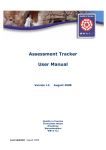
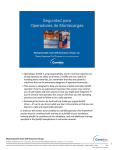
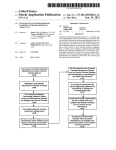
![j:j_"Xt$l"j:]:":,lg]:"r/Human Resources have been duty - e](http://vs1.manualzilla.com/store/data/005657435_1-26d97049bf04f0fd92265d73e45a9ab3-150x150.png)

